Crop Models: Important Tools in Decision Support System to Manage Wheat Production under Vulnerable Environments
Abstract
:1. Introduction
2. Material and Methods
2.1. Field Experiments
2.2. Environmental Conditions of the Experimental Site
2.3. Soil Characteristics at the Experimental Site
2.4. Measurements of Lyallpur Soil Series Data
2.5. Sampling Methodology Regarding Growth Parameters
2.6. Farmers’ Field Data
2.7. Climatic Conditions of Rice-Wheat Cropping System
2.8. Soil and Soil Series Characteristics of Rice-Wheat Cropping System
2.9. Crop Models Descriptions and Calibration
2.10. Statistical Analysis
2.11. Models Evaluation at Farmers’ Field
3. Results
3.1. Cultivars Coefficient Estimation and Models Parametrization
3.2. Evaluation of the CERES-Wheat and APSIM-Wheat Models
3.3. Prediction of Wheat Phenology
3.4. Leaf Area Index (LAI)
3.5. Total Dry Matter
3.6. Grain Yield
3.7. CERES-Wheat and APSIM-Wheat Evaluation at Farmer’s Field
4. Discussion
4.1. Wheat Cultivars Genetic Coefficients
4.2. Phenology
4.3. Leaf Area Index (LAI) and Total Dry Matter
4.4. Grain Yield
4.5. CERES-Wheat and APSIM-Wheat Evaluation at Farmers’ Field
5. Conclusions
Supplementary Materials
Author Contributions
Funding
Institutional Review Board Statement
Data Availability Statement
Acknowledgments
Conflicts of Interest
References
- Jones, J.W.; Hoogenboom, G.; Porter, C.H.; Boote, K.J.; Batchelor, W.D.; Hunt, L.A.; Wilkens, P.W.; Singh, U.; Gijsman, A.J.; Ritchie, J.T. The DSSAT Cropping System Model. Eur. J. Agron. 2003, 18, 235–265. [Google Scholar] [CrossRef]
- Hussain, K.; Wongleecharoen, C.; Hilger, T.; Ahmad, A.; Kongkaew, T.; Cadisch, G. Modelling resource competition and its mitigation at the crop-soil-hedge interface using WaNuLCAS. Agrofor. Syst. 2016, 90, 1025–1044. [Google Scholar] [CrossRef]
- Yin, X.; Struik, P.C. Applying Modelling Experiences from the Past to Shape Crop Systems Biology: The Need to Converge Crop Physiology and Functional Genomics. New Phytol. 2008, 179, 629–642. [Google Scholar] [CrossRef] [PubMed]
- Rötter, R.; Tao, F.; Höhn, J.G.; Palosuo, T. Use of Crop Simulation Modelling to Aid Ideotype Design of Future Cereal Cultivars. J. Exp. Bot. 2015, 66, 3463–3476. [Google Scholar] [CrossRef] [Green Version]
- Hussain, K. Measuring and Modelling Resource Use Competition at the Crop-Soil-Hedge Interface on a Hillside in Western Thailand; Uni-Hohenheim: Stuttgart, Germany, 2015; pp. 1–136. [Google Scholar]
- Hussain, K.; Ilyas, A.; Wajid, A.; Ahmad, A.; Mahmood, N.; Hilger, T.; Kongkaew, T. Alley Cropping Simulation: An Opportunity for Sustainable Crop Production on Tropical Uplands. Pak. J. Agric. Sci. 2019, 56, 109–112. [Google Scholar] [CrossRef]
- Arora, V.; Singh, H.; Singh, B. Analyzing Wheat Productivity Responses to Climatic, Irrigation and Fertilizer-Nitrogen Regimes in a Semi-Arid Sub-Tropical Environment Using the CERES-Wheat Model. Agric. Water Manag. 2007, 94, 22–30. [Google Scholar] [CrossRef]
- Singh, A.K.; Tripathy, R.; Chopra, U.K. Evaluation of CERES-Wheat and CropSyst Models for Water–Nitrogen Interactions in Wheat Crop. Agric. Water Manag. 2008, 95, 776–786. [Google Scholar] [CrossRef]
- Montazar, A.; Mohseni, M. Optimizing Wheat Water Productivity as Affected by Irrigation and Fertilizer-nitrogen Regimes in an Arid Environment. J. Agric. Sci. 2011, 3, p143. [Google Scholar] [CrossRef]
- Hoogenboom, G. Contribution of Agrometeorology to the Simulation of Crop Production and its Applications. Agric. For. Meteorol. 2000, 103, 137–157. [Google Scholar] [CrossRef]
- Boote, K.J.; Jones, J.W.; Hoogenboom, G.; White, J.W. The Role of Crop Systems Simulation in Agriculture and Environment. Int. J. Agric. Environ. Inf. Syst. 2010, 1, 41–54. [Google Scholar] [CrossRef]
- Parry, M.; Rosenzweig, C.; Livermore, M. Climate Change, Global Food Supply and Risk of Hunger. Philos. Trans. R. Soc. B Biol. Sci. 2005, 360, 2125–2138. [Google Scholar] [CrossRef] [Green Version]
- Bannayan, M.; Crout, N.; Hoogenboom, G. Application of the CERES-Wheat Model for Within-Season Prediction of Winter Wheat Yield in the United Kingdom. Agron. J. 2003, 95, 114–125. [Google Scholar] [CrossRef]
- Farage, P.; Ardö, J.; Olsson, L.; Rienzi, E.; Ball, A.; Pretty, J. The Potential for Soil Carbon Sequestration in Three Tropical Dryland Farming Systems of Africa and Latin America: A Modelling Approach. Soil Tillage Res. 2007, 94, 457–472. [Google Scholar] [CrossRef]
- Malone, R.; Huth, N.; Carberry, P.; Ma, L.; Kaspar, T.; Karlen, D.; Meade, T.; Kanwar, R.; Heilman, P. Evaluating and Predicting Agricultural Management Effects under Tile Drainage Using Modified APSIM. Geoderma 2007, 140, 310–322. [Google Scholar] [CrossRef] [Green Version]
- Kalra, N.; Chakraborty, D.; Kumar, P.R.; Jolly, M.; Sharma, P. An Approach to Bridging Yield Gaps, Combining Response to Water and other Resource Inputs for Wheat in Northern India, Using Research Trials and Farmers’ Fields Data. Agric. Water Manag. 2007, 93, 54–64. [Google Scholar] [CrossRef]
- Evett, S.R.; Tolk, J.A. Introduction: Can Water Use Efficiency be Modeled Well Enough to Impact Crop Management? Agron. J. 2009, 101, 423–425. [Google Scholar] [CrossRef]
- Keating, B.A.; Carberry, P.S.; Hammer, G.L.; Probert, M.E.; Robertson, M.J.; Holzworth, D.; Huth, N.I.; Hargreaves, J.N.G.; Meinke, H.; Hochman, Z.; et al. An Overview of APSIM, a Model Designed for Farming Systems Simulation. Eur. J. Agron. 2003, 18, 267–288. [Google Scholar] [CrossRef] [Green Version]
- Yunusa, I.A.M.; Bellotti, W.D.; Moore, A.D.; Probert, M.E.; Baldock, J.A.; Miyan, S.M. An Exploratory Evaluation of APSIM to Simulate Growth and Yield Processes for Winter Cereals in Rotation Systems in South Australia. Aust. J. Exp. Agric. 2004, 44, 787–800. [Google Scholar] [CrossRef]
- Van Ittersum, M.; Howden, S.; Asseng, S. Sensitivity of Productivity and Deep Drainage of Wheat Cropping Systems in a Mediterranean Environment to Changes in CO2, Temperature and Precipitation. Agric. Ecosyst. Environ. 2003, 97, 255–273. [Google Scholar] [CrossRef]
- Carberry, P.; Hochman, Z.; McCown, R.; Dalgliesh, N.; Foale, M.; Poulton, P.; Hargreaves, J.; Hargreaves, D.; Cawthray, S.; Hillcoat, N.; et al. The FARMSCAPE Approach to Decision Support: Farmers’, Advisers’, Researchers’ Monitoring, Simulation, Communication and Performance Evaluation. Agric. Syst. 2002, 74, 141–177. [Google Scholar] [CrossRef]
- Palosuo, T.; Kersebaum, K.C.; Angulo, C.; Hlavinka, P.; Moriondo, M.; Olesen, J.E.; Patil, R.H.; Ruget, F.; Rumbaur, C.; Takáč, J.; et al. Simulation of Winter Wheat Yield and Its Variability in Different Climates of Europe: A Comparison of Eight Crop Growth Models. Eur. J. Agron. 2011, 35, 103–114. [Google Scholar] [CrossRef] [Green Version]
- Fodor, N.; Máthéné-Gáspár, G.; Pokovai, K.; Kovács, G.J. 4M-Software Package for Modelling Cropping Systems. Eur. J. Agron. 2003, 18, 389–393. [Google Scholar] [CrossRef]
- Chen, C.; Wang, E.; Yu, Q. Modelling the Effects of Climate Variability and Water Management on Crop Water Productivity and Water Balance in the North China Plain. Agric. Water Manag. 2010, 97, 1175–1184. [Google Scholar] [CrossRef]
- Adam, M.; Belhouchette, H.; Corbeels, M.; Ewert, F.; Perrin, A.; Casellas, E.; Celette, F.; Wery, J. Protocol to support model selection and evaluation in a modular crop modelling framework: An application for simulating crop response to nitrogen supply. Comput. Electron. Agric. 2012, 86, 43–54. [Google Scholar] [CrossRef]
- Ferrise, R.; Moriondo, M.; Bindi, M. Probabilistic Assessments of Climate Change Impacts on Durum Wheat in the Mediterranean Region. Nat. Hazards Earth Syst. Sci. 2011, 11, 1293–1302. [Google Scholar] [CrossRef]
- Børgesen, C.D.; Olesen, J.E. A Probabilistic Assessment of Climate Change Impacts on Yield and Nitrogen Leaching from Winter Wheat in Denmark. Nat. Hazards Earth Syst. Sci. 2011, 11, 2541–2553. [Google Scholar] [CrossRef] [Green Version]
- Rötter, R.; Palosuo, T.; Kersebaum, K.C.; Angulo, C.; Bindi, M.; Ewert, F.; Ferrise, R.; Hlavinka, P.; Moriondo, M.; Nendel, C.; et al. Simulation of Spring Barley Yield in Different Climatic Zones of Northern and Central Europe: A Comparison of Nine Crop Models. Field Crop. Res. 2012, 133, 23–36. [Google Scholar] [CrossRef]
- Van Rees, H.; McClelland, T.; Hochman, Z.; Carberry, P.; Hunt, J.; Huth, N.; Holzworth, D. Leading Farmers in South East Australia Have Closed the Exploitable Wheat Yield Gap: Prospects for Further Improvement. Field Crop. Res. 2014, 164, 1–11. [Google Scholar] [CrossRef]
- Martre, P.; Wallach, D.; Asseng, S.; Ewert, F.; Jones, J.W.; Rötter, R.; Boote, K.; Ruane, A.C.; Thorburn, P.J.; Cammarano, D.; et al. Multimodel Ensembles of Wheat Growth: Many Models are Better than One. Glob. Chang. Biol. 2015, 21, 911–925. [Google Scholar] [CrossRef]
- Soltani, A.; Sinclair, T.R. A Comparison of Four Wheat Models with Respect to Robustness and Transparency: Simulation in a Temperate, Sub-Humid Environment. Field Crop. Res. 2015, 175, 37–46. [Google Scholar] [CrossRef]
- Rosenberg, N.J. Climate Change, Agriculture, Water Resources: What Do We Tell Those That Need to Know? Clim. Chang. 2010, 100, 113. [Google Scholar] [CrossRef]
- Moodie, C.D.; Smith, H.W.; McCreery, R.A. Laboratory Manual for Soil Fertility; LWW: Washington, DC, USA, 1951; Volume 71, ISBN 0038-075X. [Google Scholar]
- Gijsman, A.J.; Hoogenboom, G.; Parton, W.J.; Kerridge, P.C. Modifying DSSAT Crop Models for Low-Input Agricultural Systems Using a Soil Organic Matter–Residue Module from CENTURY. Agron. J. 2002, 94, 462–474. [Google Scholar] [CrossRef]
- Porter, C.H.; Jones, J.W.; Adiku, S.; Gijsman, A.J.; Gargiulo, O.; Naab, J.B. Modeling Organic Carbon and Carbon-Mediated Soil Processes in DSSAT v4.5. Oper. Res. 2010, 10, 247–278. [Google Scholar] [CrossRef]
- Wong, M.T.F.; Asseng, S. Determining the Causes of Spatial and Temporal Variability of Wheat Yields at Sub-field Scale Using a New Method of Upscaling a Crop Model. Plant Soil 2006, 283, 203–215. [Google Scholar] [CrossRef]
- Zheng, B.; Chenu, K.; Doherty, A.; Chapman, S. The APSIM-Wheat Module (7.5 R3008). Agric. Prod. Syst. Simulator (APSIM) Initiat. 2014, 615. [Google Scholar]
- Asseng, S.; van Keulen, H.; Stol, W. Performance and application of the APSIM N Wheat Model in the Netherlands. Eur. J. Agron. 2000, 12, 37–54. [Google Scholar] [CrossRef]
- Ma, L.; Ahuja, L.R.; Saseendran, S.A.; Malone, R.W.; Green, T.R.; Nolan, B.T.; Bartling, P.N.S.; Flerchinger, G.N.; Boote, K.J.; Hoogenboom, G. A Protocol for Parameterization and Calibration of RZWQM2 in Field Research. In Methods of Introducing System Models into Agricultural Research; John Wiley & Sons Ltd.: New York, NY, USA, 2011; pp. 1–64. ISBN 9780891181965. [Google Scholar]
- Zhao, G.; Bryan, B.A.; Song, X. Sensitivity and Uncertainty Analysis of the APSIM-Wheat Model: Interactions Between Cultivar, Environmental, and Management Parameters. Ecol. Model. 2014, 279, 1–11. [Google Scholar] [CrossRef]
- Willmott, C.J. Some Comments on the Evaluation of Model Performance. Bull. Am. Meteorol. Soc. 1982, 63, 1309–1313. [Google Scholar] [CrossRef] [Green Version]
- Walker, W.E.; Harremoës, P.; Rotmans, J.; van der Sluijs, J.P.; van Asselt, M.B.A.; Janssen, P.; Krayer von Krauss, M.P. Defining Uncertainty: A Conceptual Basis for Uncertainty Management in Model-Based Decision Support. Integr. Assess. 2003, 4, 5–17. [Google Scholar] [CrossRef] [Green Version]
- Rezzoug, W.; Gabrielle, B.; Suleiman, A.; Benabdeli, K. Application and Evaluation of the DSSAT-Wheat in the Tiaret Region of Algeria. Afr. J. Agric. 2008, 3, 284–296. [Google Scholar]
- Rinaldi, M. Water Availability at Sowing and Nitrogen Management of Durum Wheat: A Seasonal Analysis with the CERES-Wheat Model. Field Crop. Res. 2004, 89, 27–37. [Google Scholar] [CrossRef]
- Yang, Y.; Watanabe, M.; Zhang, X.; Hao, X.; Zhang, J. Estimation of Groundwater Use by Crop Production Simulated by DSSAT-Wheat and DSSAT-Maize Models in the Piedmont Region of the North China Plain. Hydrol. Process. 2006, 20, 2787–2802. [Google Scholar] [CrossRef]
- Nakayama, T.; Yang, Y.; Watanabe, M.; Zhang, X. Simulation of Groundwater Dynamics in the North China Plain by Coupled Hydrology and Agricultural Models. Hydrol. Process. 2006, 20, 3441–3466. [Google Scholar] [CrossRef]
- Ghaffari, A.; Cook, H.; Lee, H. Simulating Winter Wheat Yields under Temperate Conditions: Exploring Different Management Scenarios. Eur. J. Agron. 2001, 15, 231–240. [Google Scholar] [CrossRef]
- Saseendran, S.; Trout, T.; Ahuja, L.; Ma, L.; McMaster, G.; Nielsen, D.; Andales, A.; Chávez, J.; Ham, J. Quantifying Crop Water Stress Factors from Soil Water Measurements in a Limited Irrigation Experiment. Agric. Syst. 2015, 137, 191–205. [Google Scholar] [CrossRef]
- Singh, H.; Singh, K.N.; Hasan, B. Evaluation of CERES-Rice Model (V. 4.0) under Temperate Conditions of Kashmir Valley, India. Cereal Res. Commun. 2007, 35, 1723–1732. [Google Scholar] [CrossRef]
- Nasim, W.; Ahmad, A.; Wajid, S.A.; Hussain, A.; Khaliq, T.; Usman, M.; Hammad, H.M.; Sultana, S.R.; Mubeen, M.; Ahmad, S. Simulation of Different Wheat Cultivars under Agro-Ecological Condition of Faisalabad-Pakistan. Crop. Environ. 2010, 1, 44–48. [Google Scholar]
- Timsina, J.; Humphreys, E. Performance of CERES-Rice and CERES-Wheat Models in Rice–Wheat Systems: A Review. Agric. Syst. 2006, 90, 5–31. [Google Scholar] [CrossRef]
- Gabrielle, B.; Roche, R.; Angas, P.; Cantero-Martínez, C.; Cosentino, L.; Mantineo, M.; Langensiepen, M.; Hénault, C.; Laville, P.; Nicoullaud, B.; et al. A Priori Parameterisation of the CERES Soil-Crop Models and Tests Against Several European Data Sets. Agronomie 2002, 22, 119–132. [Google Scholar] [CrossRef] [Green Version]
- Overman, A.R.; Wilkinson, S.R.; Evers, G.W. Yield Response of Bermudgrass and Bahiagrass to Applied Nitrogen and Overseeded Clover. Agron. J. 1992, 84, 998–1001. [Google Scholar] [CrossRef]
- Liu, Y.; Wang, E.; Yang, X.; Wang, J. Contributions of Climatic and Crop Varietal Changes to Crop Production in the North China Plain, since 1980s. Glob. Chang. Biol. 2010, 16, 2287–2299. [Google Scholar] [CrossRef]
- Zhang, Y.; Feng, L.; Wang, E.; Wang, J.; Li, B. Evaluation of the APSIM-Wheat Model in Terms of Different Cultivars, Management Regimes and Environmental Conditions. Can. J. Plant Sci. 2012, 92, 937–949. [Google Scholar] [CrossRef] [Green Version]
- Kumar, R.; Singh, K.K.; Gupta, B.R.D.; Baxla, A.K.; Rathore, L.S.; Attri, S.D. Optimum Sowing Dates for Soybean in Central India Using CROPGRO and Climprob Symbiosis. Meteorol. Appl. 2002, 9, 247–254. [Google Scholar] [CrossRef]
- Andarziyan, B.; Bakhshande, A.; Banayan Aval, M.; Emam, Y. Evaluation of the CERES-Wheat Model in Ahvaz Condition. Iran. J. Field Crop. 2008, 6, 11–22. [Google Scholar]
- Kaspar, T.C.; Bland, W.L. Soil Temperature and Root Growth. Soil Sci. 1992, 154, 290–299. [Google Scholar] [CrossRef]
- Pathak, H.; Ladha, J.; Aggarwal, P.; Peng, S.; Das, S.; Singh, Y.; Singh, B.; Kamra, S.; Mishra, B.; Sastri, A.; et al. Trends of Climatic Potential and On-Farm Yields of Rice and Wheat in the Indo-Gangetic Plains. Field Crop. Res. 2003, 80, 223–234. [Google Scholar] [CrossRef]
- Aggarwal, P.; Kalra, N.; Singh, A.; Sinha, S. Analyzing the Limitations Set by Climatic Factors, Genotype, Water and Nitrogen Availability on Productivity of Wheat I. The Model Description, Parametrization and Validation. Field Crop. Res. 1994, 38, 73–91. [Google Scholar] [CrossRef]
- Bassu, S.; Asseng, S.; Motzo, R.; Giunta, F. Optimising Sowing Date of Durum Wheat in a Variable Mediterranean Environment. Field Crop. Res. 2009, 111, 109–118. [Google Scholar] [CrossRef]
- Duggan, B.L.; Richards, R.A.; Van Herwaarden, A.F.; Fettell, N.A. Agronomic Evaluation of a Tiller Inhibition Gene (Tin) in Wheat. I. Effect on Yield, Yield Components, and Grain Protein. Aust. J. Agric. Res. 2005, 56, 169–178. [Google Scholar] [CrossRef]
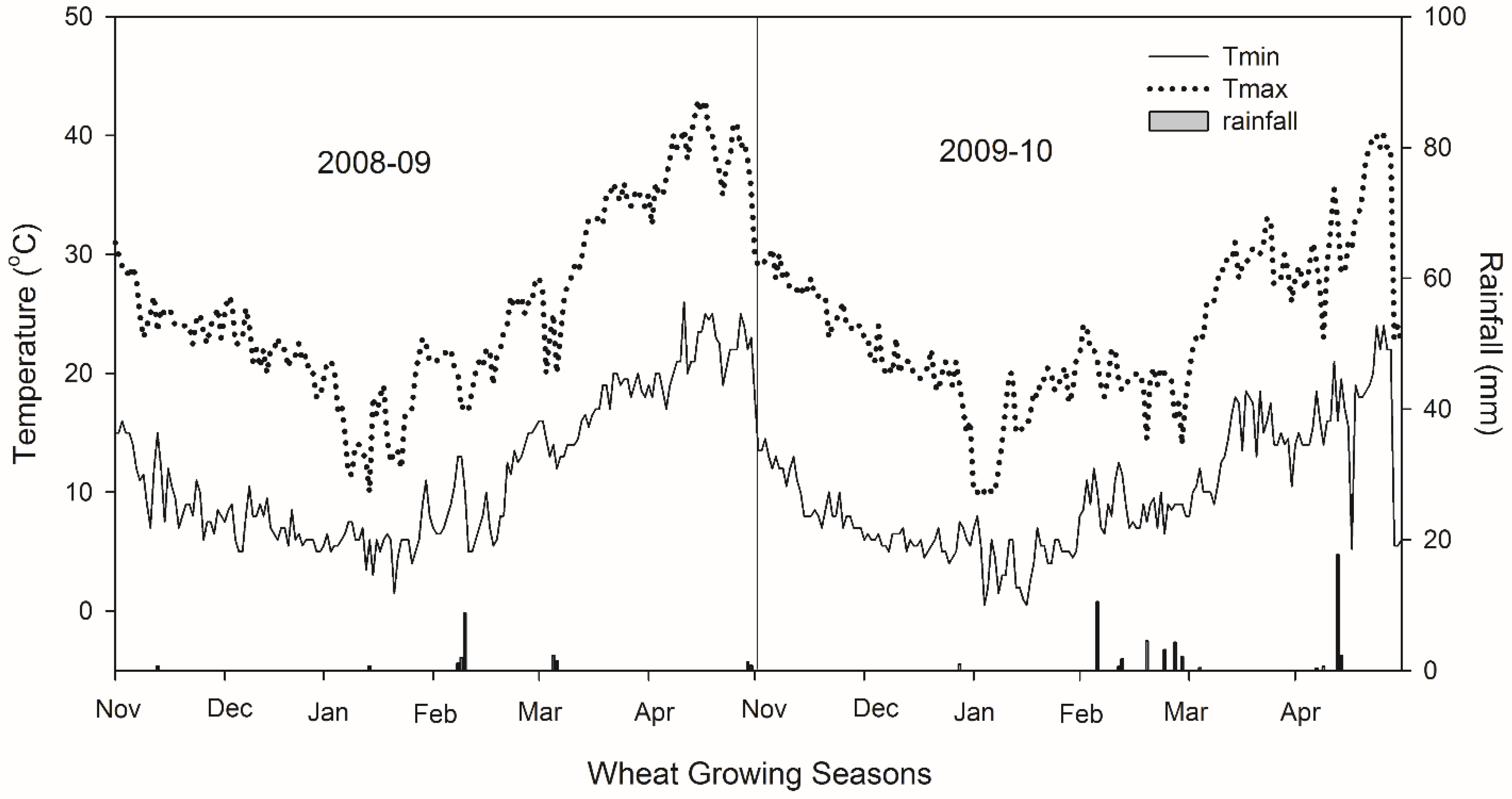

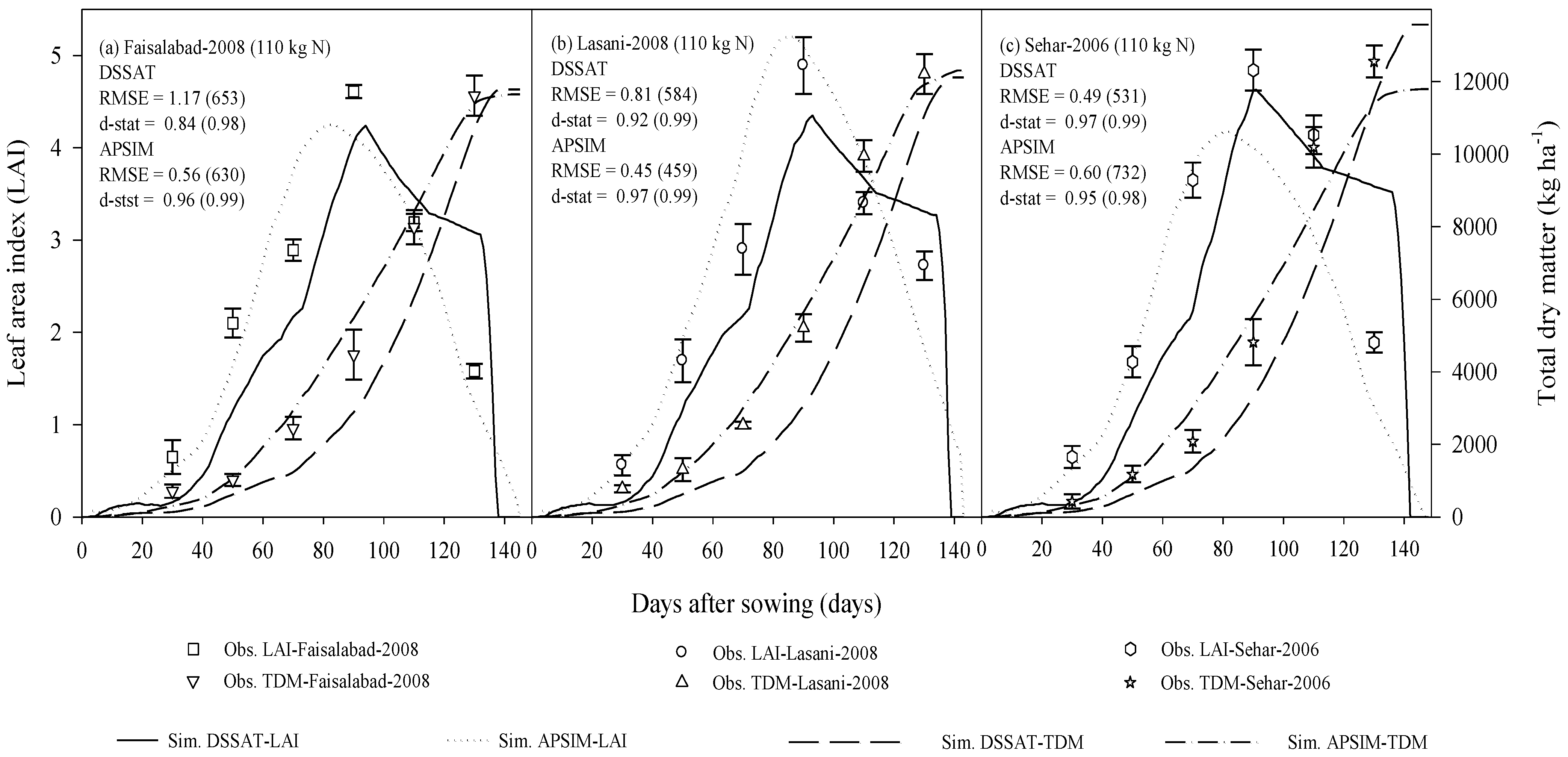

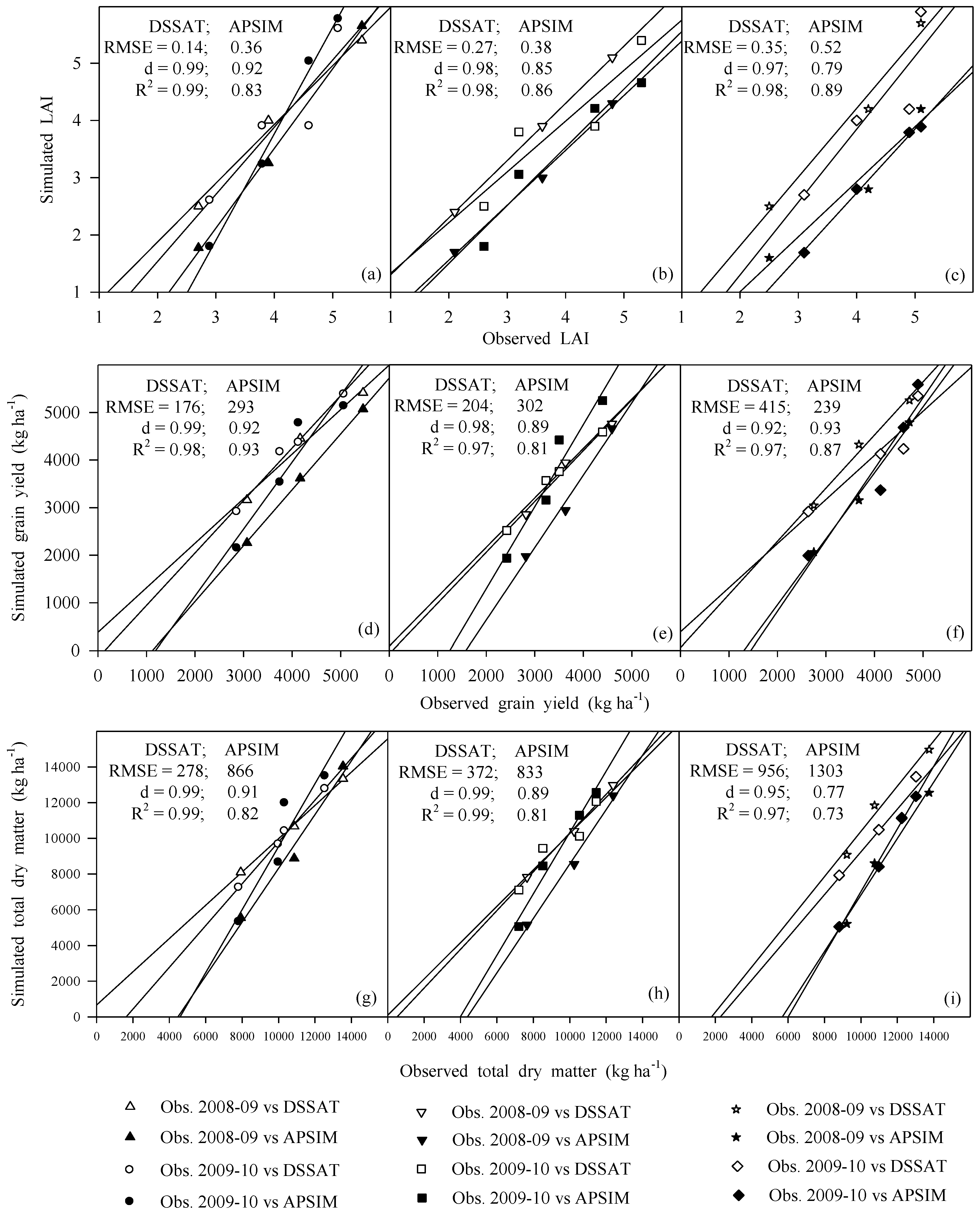

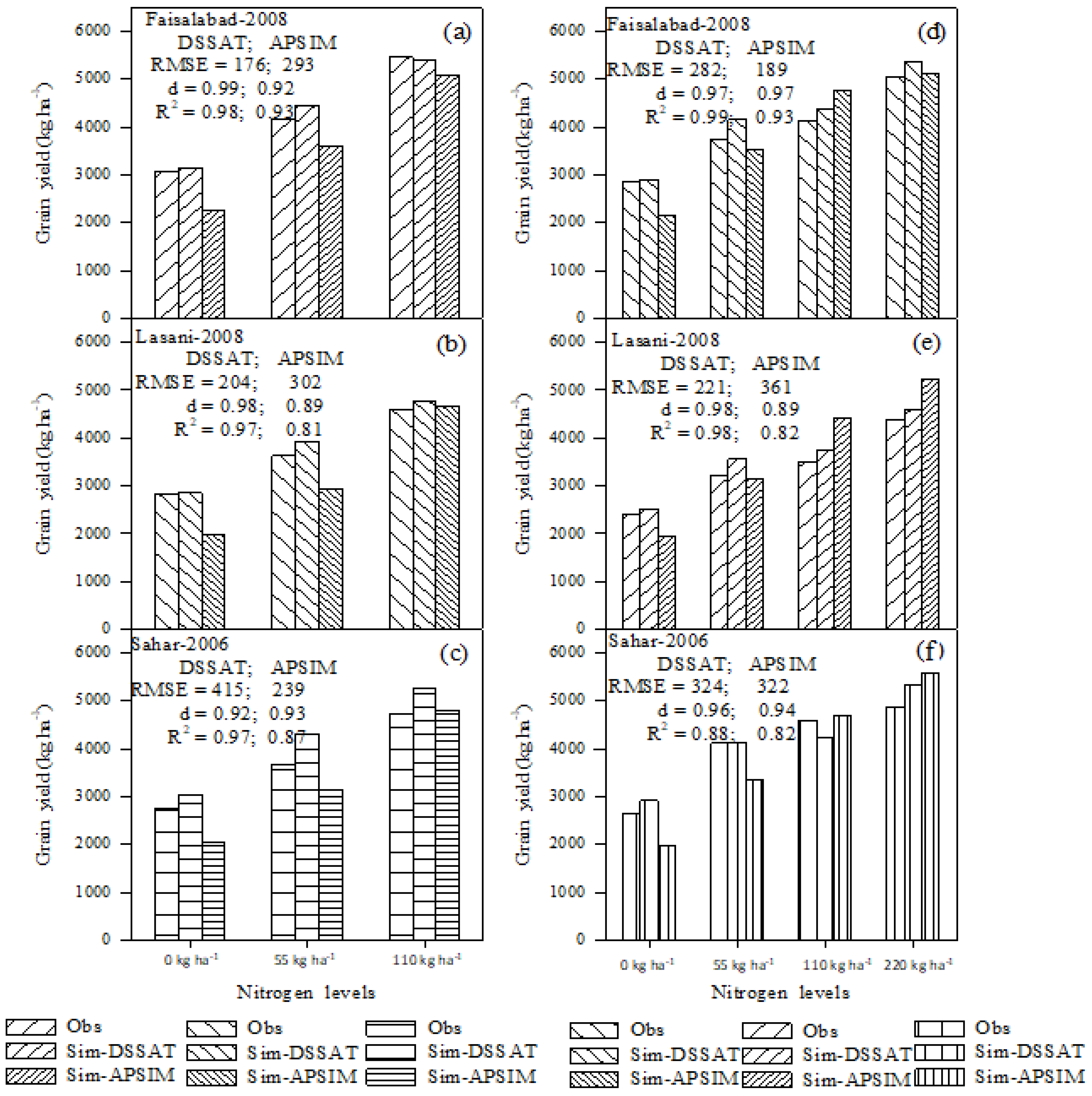
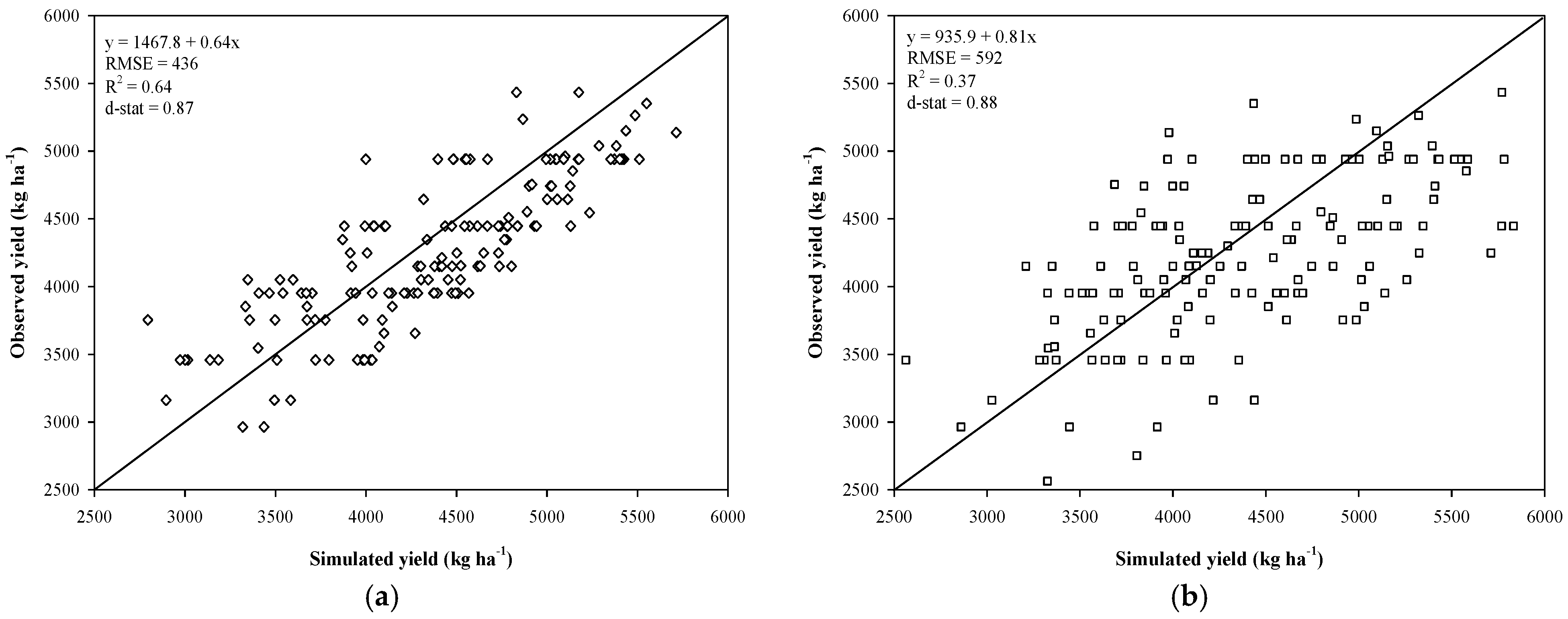
| Cultivars | P1V (Days) | P1D | P5 (°C.d) | G1 (#/g) | G2 (mg) | G3 (g dwt) | PHINT (°C.d) |
|---|---|---|---|---|---|---|---|
| Faisalabad-2008 | 22 | 41 | 596 | 31 | 28 | 1.3 | 70 |
| Lasani-2008 | 19 | 45 | 510 | 32 | 24 | 1.9 | 68 |
| Sehar-2006 | 16 | 40 | 691 | 37 | 22 | 1.2 | 74 |
| Faisalabad-2008 | Lasani-2008 | Sahar-2006 | |
|---|---|---|---|
| 1 Emerg_to_endjuv (°d) | 422.0 | 389 | 390 |
| 2 Startgf_to_ mat (°d) | 560 | 549 | 628 |
| 3 Potential_grain_filling_rate (g per kernel per day) | 0.0020 | 0.0010 | 0.0010 |
| 4 Grains_per_gram_stem (g per stem) | 24.0 | 35.5 | 28.0 |
| 5 Max_grain_size (g per kernel) | 0.046 | 0.063 | 0.062 |
| 6 Vern_sens | 2.5 | 2.16 | 2.35 |
| 7 Photop_sens | 3.59 | 3.82 | 3.32 |
| Parameters | Cultivar Faisalabad-2008 | Cultivar Lasani-2008 | Cultivar Sahar-2006 | ||||||||||||
|---|---|---|---|---|---|---|---|---|---|---|---|---|---|---|---|
| (DSSAT) | (APSIM) | (DSSAT) | (APSIM) | (DSSAT) | (APSIM) | ||||||||||
| Obs. | Sim. | PD | Sim. | PD | Obs. | Sim. | PD | Sim. | PD | Obs. | Sim. | PD | Sim. | PD | |
| Days to anthesis | 106 | 106 | 0 | 107 | 0.94 | 108 | 108 | 0 | 110 | 1.85 | 107 | 105 | 1.87 | 109 | 1.87 |
| Days to maturity | 142 | 142 | 0 | 143 | 0.70 | 141 | 140 | 0.71 | 145 | 2.84 | 146 | 145 | 0.68 | 148 | 1.37 |
| Maximum LAI | 4.70 | 4.35 | −7.92 | 5.20 | 10.66 | 4.5 | 4.3 | −4.44 | 4.25 | −5.56 | 4.8 | 4.70 | −2.08 | 4.17 | −13.04 |
| Grain yield (kg ha−1) | 4897 | 4857 | 0.82 | 4857 | 0.82 | 4256 | 4303 | 1.10 | 4236 | 0.47 | 4488 | 4705 | 4.84 | 4343 | 3.23 |
| Above ground biomass (kg ha−1) | 12,317 | 12,118 | 1.62 | 12,312 | 0.04 | 11,614 | 11,787 | 1.49 | 11,652 | 0.33 | 12,561 | 12,978 | 3.32 | 11,795 | 6.10 |
Publisher’s Note: MDPI stays neutral with regard to jurisdictional claims in published maps and institutional affiliations. |
© 2021 by the authors. Licensee MDPI, Basel, Switzerland. This article is an open access article distributed under the terms and conditions of the Creative Commons Attribution (CC BY) license (https://creativecommons.org/licenses/by/4.0/).
Share and Cite
Wajid, A.; Hussain, K.; Ilyas, A.; Habib-ur-Rahman, M.; Shakil, Q.; Hoogenboom, G. Crop Models: Important Tools in Decision Support System to Manage Wheat Production under Vulnerable Environments. Agriculture 2021, 11, 1166. https://doi.org/10.3390/agriculture11111166
Wajid A, Hussain K, Ilyas A, Habib-ur-Rahman M, Shakil Q, Hoogenboom G. Crop Models: Important Tools in Decision Support System to Manage Wheat Production under Vulnerable Environments. Agriculture. 2021; 11(11):1166. https://doi.org/10.3390/agriculture11111166
Chicago/Turabian StyleWajid, Aftab, Khalid Hussain, Ayesha Ilyas, Muhammad Habib-ur-Rahman, Qamar Shakil, and Gerrit Hoogenboom. 2021. "Crop Models: Important Tools in Decision Support System to Manage Wheat Production under Vulnerable Environments" Agriculture 11, no. 11: 1166. https://doi.org/10.3390/agriculture11111166
APA StyleWajid, A., Hussain, K., Ilyas, A., Habib-ur-Rahman, M., Shakil, Q., & Hoogenboom, G. (2021). Crop Models: Important Tools in Decision Support System to Manage Wheat Production under Vulnerable Environments. Agriculture, 11(11), 1166. https://doi.org/10.3390/agriculture11111166






